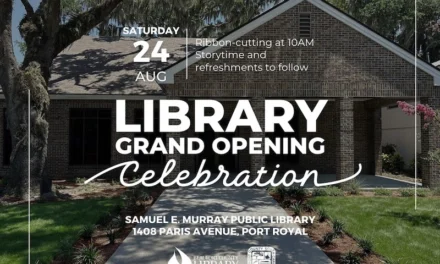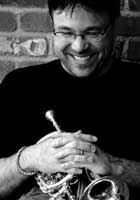Two centuries of history revealed in restoration of Beaufort’s Verdier House front door frame.

Chad Bond working on the Verdier House door frame.
From staff reports
Layer by careful layer, 219 years of history surfaces in a most unlikely place – the area surrounding the front door of the historic John Mark Verdier House in downtown Beaufort.
The ongoing work by master carpenter and restoration craftsman Chad Bond of Charleston is helping Historic Beaufort Foundation learn more about the Verdier House, its premier property and public house museum.
“After the sensitive removal of layers of paint by conservation lab specialist and paint analyst Frances Ford, it was discovered that more than 219 years of weathering had resulted in the wear and loss of some architectural elements on the decorative pilasters and frieze,” said Lise Sundrla, assistant director at Historic Beaufort Foundation.
Ford is an adjunct professor and conservation lecturer at the College of Charleston and a graduate of Clemson University’s historic preservation program.
“As Chad has continued the removal of layers and decades of paint on the door surround, he is revealing the delicate and intricate craftsmanship on the decorative pilasters and frieze surrounding the front door of the house.
“This effort is even more amazing when you realize these extraordinary design elements were created 219 years ago by a craftsman not unlike Chad,” Sundrla said.
This restoration effort is possible thanks to the gracious support of Patricia and Colden Battey, Greg and Sarah Dyson, and Cheryl Steele in memory of her husband Roger Steele.
Sarah Dyson, and Cheryl Steele in memory of her husband Roger Steele.
Between 1801 and 1805, John Mark Verdier built the house on Bay Street in Beaufort’s downtown. He was a successful merchant, owning more than 1,000 acres on Lady’s Island along the Coosaw River where he grew Sea Island cotton. His house features typical Beaufort Style architectural elements: It faces south, is built on a high tabby foundation, has a two-story pedimented portico and low-pitched hip roof.
During this restoration process, Bond found the long-lost pattern on the two composite medallions at the top of the pilasters which frame the door — a floral motif typical of the Federal Period. Restoration is underway on the decorative architectural elements surrounding the front door of the John Mark Verdier House.
“There were many, many layers of paint obscuring its original design,” Bond said. “For example, on the sides of the upper brackets above the pilasters are some simple and beautiful bell flowers that adorn each side.
“These were a complete discovery as they were revived from a puddle of many layers of paint. Throughout the restoration, the original crispness of detail was rediscovered. I’m very happy with how that turned out,” Bond said.
Historic Beaufort Foundation Executive Director Cynthia Jenkins said her favorite part of the door restoration frame restoration so far has been realizing the left and right sides are no longer identical. “I was surprised to see that the decorative details on the west side of the door (left side facing the house) were more deteriorated than the details on the east side,” she said.
“The reason is pretty simple – the worst rain and weather comes from the southwest. Probably another issue is the summer sun is hotter on that side and it isn’t protected by the portico. The primary reason the Beaufort Style evolved from porticos to deep piazzas across the south front of houses was to shade the interiors, catch the breeze and provide a cool place to sit before the invention of air conditioning,” Jenkins said.
Plans for exterior and interior renovation of the house began in 2006, when HBF engaged renowned restoration paint colorist Susan Buck to test and identify the original paint colors on the John Mark Verdier House – the clapboard exterior, interior, doors and shutters.
Buck earned her Ph.D. in Art Conservation Research at the University of Delaware in 2003 and her Master’s degree from the Winterthur, the University of a Delaware Program in Art Conservation. She is an Art Conservator and Paint Analyst and lives in Williamsburg VA.
She conducted microscopy analysis on the exterior clapboard, interior plaster and woodwork along with the exterior and interior doors.
The original door of the John Mark Verdier House had been replaced with a replica during the 1970s renovation of the house as the original door was in poor condition, Sundrla noted. Because HBF still had the original door, Buck was able to conduct the microscopy analysis.
Her research showed that both the original front door and the second-floor jib-door were painted with a thin layer of deep red-brown paint, followed by a second deep red-brown paint, and then a grain-painting sequence in the third-generation. This was typical of houses in that time-period to grain their doors to give the appearance of mahogany as a show of wealth and stature.
Jenkins said the toughest decision was whether to restore the original front door or to faux grain the 1970’s reproduction. In the end it seemed best to save the original door, to keep it in storage out of the elements. “Technology will continue to progress and in another 50 years that door might shed valuable information,” she said.
The John Mark Verdier House is a premiere representation of Beaufort’s residential architecture and was a highly visible statement of Verdier’s rise as a successful merchant and planter in the early 1800s.
 A 2012 repainting of the exterior brought the house back to ca.1863 when the color was a pinkish-tan. At that time the house was occupied by the Union Troops as the Adjutant General’s Office for the duration of the war.
A 2012 repainting of the exterior brought the house back to ca.1863 when the color was a pinkish-tan. At that time the house was occupied by the Union Troops as the Adjutant General’s Office for the duration of the war.
In 2017, HBF launched the “Paint the Lady Campaign” with the goal of exterior repair and painting of the house. The decision was made to bring the house back to the period of its construction, ca. 1804, when the Verdier family resided in the home. Work began in 2020 and the exterior paint and clapboard repair was completed in 2021.
Master colorist Stephanie Poe was engaged in December 2022 to grain the 1970s replica door to resemble mahogany. A Charleston resident, Poe has studied under three of the masters in the field, Mike McNeil, Jean Sable, and Pierre Finkelstein. She has traveled around the world to study and master the authentic and historical methods used in Italian plastering, wood graining, and marbling.
At that same time, HBF brought in master craftsman Chad Bond to restore the decorative door surround.
“It is not uncommon for a project like this to hold so much history, but I think it is uncommon to have so many people on board and excited to help bring an important piece of history back into glory,” Bond said.
Historic Beaufort Foundation is a 501(c)3 nonprofit education foundation created to preserve, protect, and present sites and artifacts of historic, architectural, and cultural interest throughout Beaufort County, South Carolina. For more information on the entity’s mission and history, please visit historicbeaufort.org and follow them on social media, including Facebook and Instagram.









